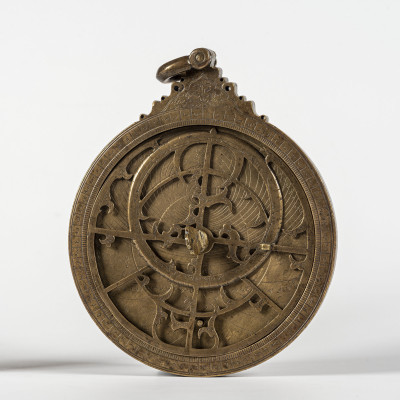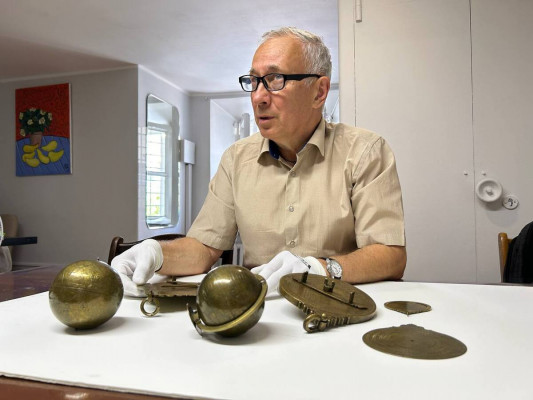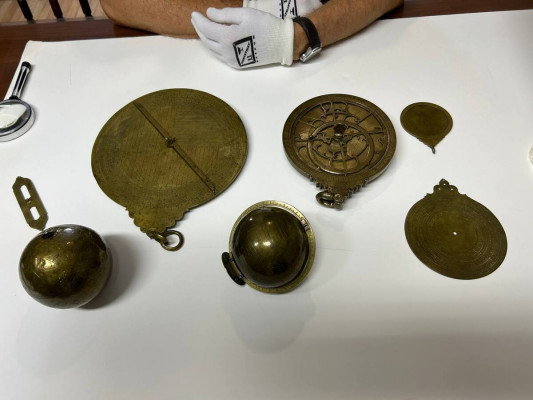Sergei Maslikov, historian of astronomy, and candidate of physical and mathematical sciences, defended his dissertation on the topic “The astrolabe as an astronomical instrument from antiquity to modern times" in 2017. The number of scientists specializing in astrolabes in Russia and the world can be counted on one hand. Sergei Maslikov is one of them. This researcher came from Novosibirsk to the State Museum of Oriental Art to study the instruments stored in the collection of this cultural institution. The State Museum of Oriental Art is the only museum in Moscow that has astrolabes in its collection.
- Why are you interested in the astrolabes that are kept in the State Museum of Oriental Art?
- Let's start with the fact that only about 1500 astrolabes have survived to this day. Most of them are in Oxford: 134. The Museum of the History of Science in Oxford was greatly developed in the 19th - early 20th centuries and bought up all available instruments. Thus, they ended up with the largest collection in the world.
In our country there are only two dozen astrolabes. Basically, they are in St. Petersburg: 9 in the Hermitage, another 3 in the Kunstkamera and one scattered in several other museums. The State Museum of Oriental Art has two full-fledged and two incomplete astrolabes: a total of four. And there are no other astrolabes in Moscow. So the astrolabes in the State Museum of Oriental Art could be interesting just by their existence. However, during my study it was discovered that these are, in principle, unique instruments. Thus, in your museum there are several interesting astronomical instruments: two complete astrolabes, two incomplete ones, plus two wonderful celestial globes, which are also of great value.
I'll start with the most famous astrolabe, which was made in the Indian city of Lahore in the 16th century. This is a copy of an earlier astrolabe, as the maker himself admits in the inscription engraved on the surface: it is a copy of the Baysungur astrolabe, which was created about a century earlier. By studying this copy, we can find out which elements of the instrument were used previously and which elements began to gradually disappear.
I will name only a few of the most interesting points that are present here. For example, there are several astrological scales in order to calculate the position of the sun, the position of the ascendant in the horoscope, and the midheaven - these are astrological terms. Using this device you can calculate a value such as a solar horoscope. Let me explain. We are used to the fact that every person has a birthday once a year, on a certain date. But in fact, the astrological significant moment occurs when the sun makes exactly one revolution across the sky and arrives at the same point in the zodiac. Sometimes the date when this occurs may move one day forward or back from your official birthday. And with the help of the device you can accurately determine the right moment. This is important for calculating the horoscope. In those days, astrologers knew about this.
You can also use the astrolabe to calculate sines, cosines, tangents - that is, mathematical functions. This now seems like a useless skill. And further… for example, assume there is an enemy tower. How do you know what its height is, how long the ropes should be to throw hooks onto that tower? But with the help of an astrolabe this is easy to calculate, of course, if you know how to use it. Another amazing feature of your astrolabe, which I have not seen in other instruments, is that it can show how long the day will last on the Arctic Circle. For some reason the Indian astronomers needed to know this. The reason is a mystery that scholars have yet to solve.
The school of astrolabe makers in Lahore, India (now Pakistan) is one of the most famous. We even know the names of 5-6 astrolabe makers in that school, because they signed their products, that is, they assumed full responsibility for their quality. But the maker of our astrolabe was embarrassed to sign it; apparently, he was not one hundred percent confident about the quality of his work.
Here is one important detail: the maker who made this astrolabe apparently did not understand how it worked, because he copied quite formally, without knowledge of mathematical laws. Still, thanks to the fact that he at least did this, we still receive a lot of valuable information: we know what the Baysungur astrolabe, which has not survived to our time, looked like. But anyone who used this copy in everyday life could easily have made mistakes.
The second astrolabe that is stored in your collection is a different type of astrolabe: it is a universal one. It looks completely different and is designed for use at different geographical latitudes.
It was probably made in the Maghreb, or perhaps Spain, and it may date back to the seventeenth century. This remains to be clarified. In the Middle Ages the astrolabe was a very common instrument, which was studied in universities. To use it, it was necessary not only to understand what each scale was for, but also to know the stellar constellations in the sky. In general, the user of the astrolabe had to be an educated person.
- Are the incomplete astrolabes from the collection of the Oriental Museum of any scientific interest?
- Yes, definitely. One of them is very small, with a diameter of just over seventy millimeters. This is the smallest astrolabe in Russia, although in foreign museums there are even smaller ones, only five centimeters in diameter. For some reason the maker did not finish it; there are empty spaces on it, not filled with scales. It's not broken, it's just unfinished for an unknown reason. Another astrolabe from the Oriental Museum is more correctly called a calendar disk, because it has many circular scales. It only looks like an astrolabe.
- Why did you choose such a topic to study; why astrolabes?
- I am an astronomer by training. In my opinion, the astrolabe is a most interesting and unusual object. In the museums where they are kept, little is known about them. And often they are not exhibited, they are kept in storage; although your astrolabe from Lahore was shown in the exhibition “Over three seas: the travel of Afanasy Nikitin.” I would like museums to be able to tell and show their visitors more about these instruments. I hope that in this way I will bring some benefit to museums.
- And now people use computers instead of astrolabes?
- Yes, now we have gadgets, and such a complex device as an astrolabe is useless. There are special computer programs that can do all the calculations for you. But I'll tell you a story. I have a model of an astrolabe at home and I practice with it. And one day I went out onto the balcony at home, saw a bright star, which seemed to be in the constellation Lyra, and decided to measure its height. And I got, say, 31 degrees. I checked this value using a computer program. But it said that at this moment the height of the star should be not 31, but 42 degrees. I was very surprised: the astrolabe cannot be mistaken by ten degrees! I called my friend who was developing this computer program. He replied: apparently you have an old version of the program, which still uses daylight saving time, which has now been abolished. This is how the device turned out to be more accurate than a modern computer program. So let's not dismiss astrolabes!
Sergei Maslikov: "The mysteries of the astrolabes of the Museum of the East have yet to be revealed"
Дата публикации 25.11.2024



